- Главная
- Разное
- Бизнес и предпринимательство
- Образование
- Развлечения
- Государство
- Спорт
- Графика
- Культурология
- Еда и кулинария
- Лингвистика
- Религиоведение
- Черчение
- Физкультура
- ИЗО
- Психология
- Социология
- Английский язык
- Астрономия
- Алгебра
- Биология
- География
- Геометрия
- Детские презентации
- Информатика
- История
- Литература
- Маркетинг
- Математика
- Медицина
- Менеджмент
- Музыка
- МХК
- Немецкий язык
- ОБЖ
- Обществознание
- Окружающий мир
- Педагогика
- Русский язык
- Технология
- Физика
- Философия
- Химия
- Шаблоны, картинки для презентаций
- Экология
- Экономика
- Юриспруденция
Что такое findslide.org?
FindSlide.org - это сайт презентаций, докладов, шаблонов в формате PowerPoint.
Обратная связь
Email: Нажмите что бы посмотреть
Презентация на тему Antigen-antibody reactions and selected tests
Содержание
- 2. NATURE OF ANTIGEN-ANTIBODY REACTIONSLock and Key ConceptThe
- 3. AFFINITY AND AVIDITYAffinityAntibody affinity is the strength
- 5. AvidityAvidity is a measure of the overall
- 7. Possible effects on soluble protein of immobilization
- 8. SPECIFICITY AND CROSS REACTIVITYSpecificitySpecificity refers to the
- 9. Diagnosis of infectious and parasitic diseases and
- 10. Cross reactivityCross reactivity refers to the ability
- 11. Agglutination testAgglutination test (agglutinacio - склеивание) -
- 12. STATEMENT OF MICROAGGLUTINATION TEST
- 13. THE RESULTS OF MICROAGGLUTINATION TEST
- 15. In positive cases precipitate has the form
- 16. PRECIPITATION TEST Principle: When interacting of
- 17. THE PRINCIPLE OF PRECIPITATION TEST
- 18. Ring-precipitation testFormation of the Ag-Ab complex
- 19. THE PRINCIPLE OF RADIAL IMMUNODIFFUSION TESTThe test
- 20. Radial Immunodiffusion (RID)
- 21. Complement fixation test
- 22. Materials and Reagents1. Sheep erythrocytes suspension (5% suspension
- 23. The principle of the complement fixation test
- 24. Procedure of Complement Fixation TestComplement Fixation Test
- 25. Enzyme linked immunosorbent assayELISA - it is
- 26. IgGIgMСерологические реакции, основанные на использовании метокМЕТКИФерментныеФлюоресцирующиерадиоизотопные
- 29. 96-луночный планшет для ИФА
- 31. Спектрофотометр для ИФА
- 32. ПРИНЦИП НЕПРЯМОГО ИФА
- 34. This variant of ELISA is extremely common
- 35. Принцип сэндвич-ИФА
- 37. Конкурентный ИФА для определения антигена (антибиотиков)Конъюгат АБ-носительСубстратАнтибиотикСпецифические АТАнтивидовой конъюгат
- 39. Конкурентный ИФА для определения специфических антител
- 40. ИСПОЛЬЗОВАНИЕ АВИДИН-БИОТИНОВОЙ СИСТЕМЫ В ИФА
- 42. Dot-ИФА
- 43. Сравнительная характеристика dot-ИФА и ИФА.
- 44. ПРИНЦИП ИММУНОХРОМАТОГРАФИЧЕСКОГО АНАЛИЗА
- 45. Оборудование для производства иммунохроматографической тест - системы
- 46. Иммунохроматографическое определение антигена (I – аналитическая зона, II – контрольная зона)
- 47. Скачать презентацию
- 48. Похожие презентации
NATURE OF ANTIGEN-ANTIBODY REACTIONSLock and Key ConceptThe combining site of an antibody is located in the Fab portion of the molecule and is constructed from the hypervariable regions of the heavy and light chains. Thus, the concept





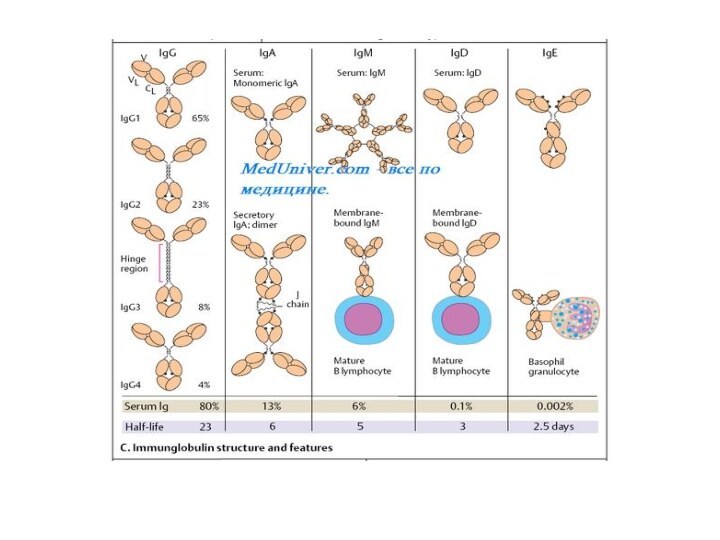











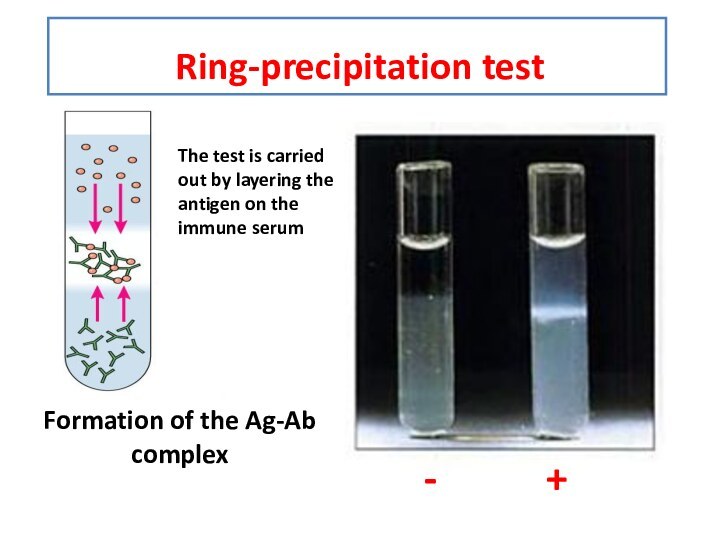

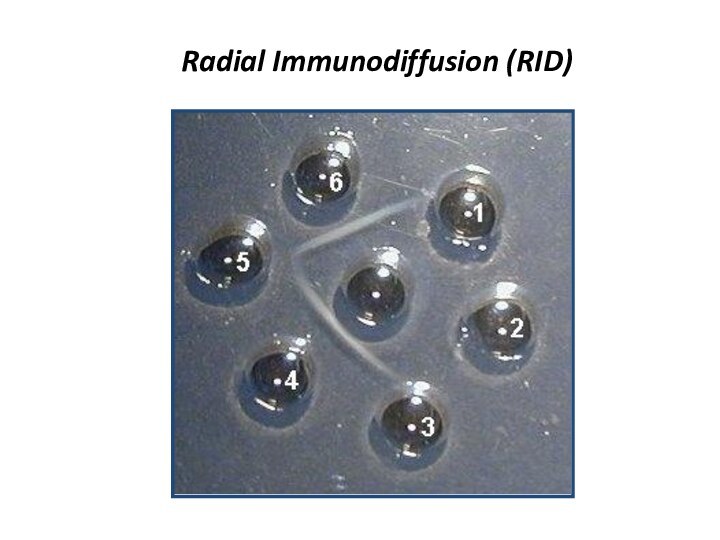

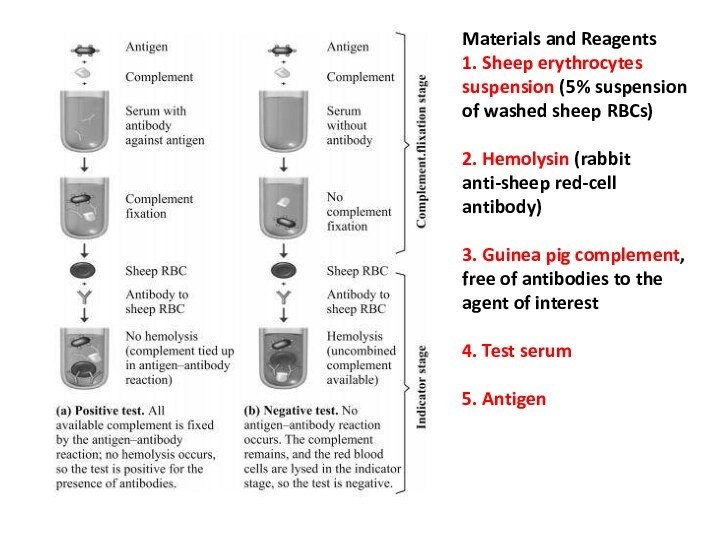















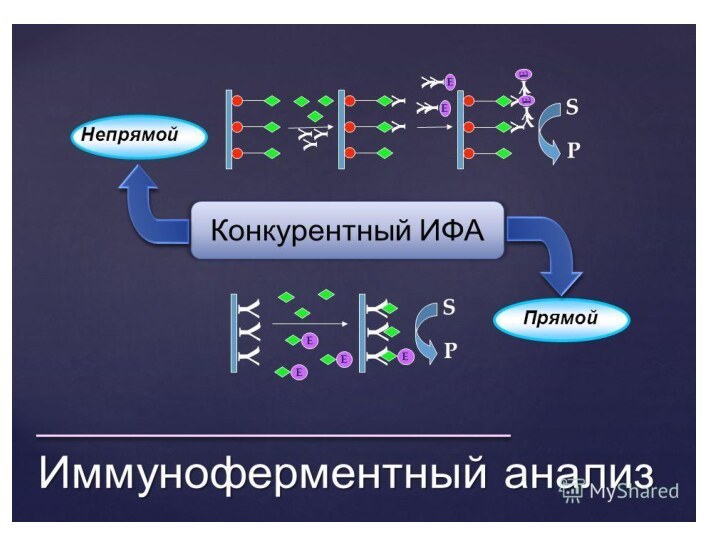









Слайд 3
AFFINITY AND AVIDITY
Affinity
Antibody affinity is the strength of
the reaction between a single antigenic determinant and a
single combining site on the antibody. It is the sum of the attractive and repulsive forces operating between the antigenic determinant and the combining site of the antibody as illustrated in Figure
Слайд 5
Avidity
Avidity is a measure of the overall strength
of binding of an antigen with many antigenic determinants
and multivalent antibodies. Avidity is influenced by both the valence of the antibody and the valence of the antigen. Avidity is more than the sum of the individual affinities. This is illustrated in Figure.To repeat, affinity refers to the strength of binding between a single antigenic determinant and an individual antibody combining site whereas avidity refers to the overall strength of binding between multivalent antigens and antibodies.
Слайд 7
Possible effects on soluble protein of immobilization
Protein
is shown as having three antigenic sites (epitopes). Two
are linear (solid box and shaded pentagon), and one is conformational dependent (shaded oval).(i) to (iii) The orientation of the molecule on the well affects the presentation of the individual epitopes. This is true of passive and covalent binding to plastic.
Aggregation of the antigen can complicate presentation and also lead to leaching following binding with detecting antibody.
The antigen may be altered through treatment before attachment. In both (i) and (ii)the conformational epitope has been destroyed. Note also that the orientation of the molecules affects the presentation and spacing between individual epitopes.
Nondenatured protein can also alter its conformation by passive adsorption to plastic.
Слайд 8
SPECIFICITY AND CROSS REACTIVITY
Specificity
Specificity refers to the ability
of an individual antibody combining site to react with
onlyone antigenic determinant or the ability of a population of antibody molecules to react with only one antigen.
In general, there is a high degree of specificity in antigen-antibody reactions.
Antibodies can distinguish differences in:
The primary structure of an antigen
Isomeric forms of an antigen
Secondary and tertiary structure of an antigen
Слайд 9
Diagnosis of infectious and parasitic diseases and the
establishment of detection antibody titers (serodiagnosis);
Diagnosis of diseases to
identify antigens of pathogens in the body;Identification of cultures of bacteria and viruses isolated from humans and animals;
Determination of the composition and characteristics of human tissue: blood group, Rh factor, transplantation antigens;
Identification of the human body and in the environment of any substances having antigenicity (hormones, enzymes, toxins, drugs, drugs, etc.).
Assessment of immune status to determine the quantitative and functional characteristics of immune system cells and their products.
Identification of immunopathological conditions, allergies, transplant and anti-tumor responses.
APLICATION OF ANTIGEN-ANTIBODY REACTIONS
Слайд 10
Cross reactivity
Cross reactivity refers to the ability of
an individual antibody combining site to react with more
than one antigenic determinant or the ability of a population of antibody molecules to react with more than one antigen. Figure illustrates how cross reactions can arise. Cross reactions arise because the cross reacting antigen shares an epitope in common with the immunizing antigen or because it has an epitope which is structurally similar to one on the immunizing antigen (multispecificity).
Слайд 11
Agglutination test
Agglutination test (agglutinacio - склеивание) - gluing
and precipitation of the bacteria under the influence of
antibodies in an environment with the electrolyte.
Слайд 15
In positive cases precipitate has the form of
a thin film of the red blood cells glued
together (umbrella).Passive Hemagglutination
Слайд 16
PRECIPITATION TEST
Principle: When interacting of soluble
antigen with antibody in the presence of electrolyte (NaCl)
complex Ag-Ab is formed as an insoluble precipitate.PT is used for two purposes: detection of antigens with the help of known antibody or antibodies using known antigens.
With the help of PT falsification of fish and meat products is determined.
Слайд 18
Ring-precipitation test
Formation of the Ag-Ab complex
-
+
The test is carried
out by layering the antigen on the immune serum
Слайд 19
THE PRINCIPLE OF RADIAL IMMUNODIFFUSION TEST
The test is
carried out in agar gel plates or in Petri
dishes. Holes are cut out In the frozen gel at some distance from each other, and filled with the solutions of antigen and antisera. In the case of optimally selected ratio of antigens to antibodies, precipitation bands are formed in the gel between the wells. Since the reagents diffuse from the wells concentrically, the method allows several simultaneous reactions to be carried out by placing several wells with antigens around the antiserum well.
Слайд 22
Materials and Reagents
1. Sheep erythrocytes suspension (5% suspension of
washed sheep RBCs)
2. Hemolysin (rabbit anti-sheep red-cell antibody)
3. Guinea
pig complement, free of antibodies to the agent of interest4. Test serum
5. Antigen
Слайд 23 The principle of the complement fixation test is
illustrated in Figure. Antigen is mixed with the test
serum to be assayed for antibody and antigen/antibody complexes are allowed to form. A control tube in which no antigen is added is also prepared. If no antigen/antibody complexes are present in the tube, none of the complement will be fixed. However, if antigen/antibody complexes are present, they will fix complement and thereby reduce the amount of complement in the tube. After allowing complement fixation by any antigen/antibody complexes, a standard amount of red blood cells, which have been pre-coated with anti-erythrocyte antibodies is added. The amount of antibody-coated red blood cells is predetermined to be just enough to completely use up all the complement initially added, if it were still there.
Слайд 24
Procedure of Complement Fixation Test
Complement Fixation Test (CFT)
consists of two stage:
First step (Complement fixation stage): a known
antigen and inactivated patient’s serum are incubated with a standardized, limited amount of complement. If the serum contains specific, complement activating antibody the complement will be activated or fixed by the antigen-antibody complex. However, if there is no antibody in the patient’s serum, there will be no formation of antigen-antibody complex, and therefore complement will not be fixed. But will remain free.Second step (Indicator Stage): The second step detects whether complement has been utilized in the first step or not. This is done by adding the indicator system.
If the complement is fixed in the first step owing to the presence of antibody there will be no complement left to fix to the indicator system. There won’t be any lysis of RBCs.
However, if there is no antibody in the patient’s serum, there will be no antigen-antibody complex, and therefore, complement will be present free or unfixed in the mixture. This unfixed complement will now react with the antibody- coated sheep red blood cells to bring about their lysis.
Results and Interpretation
Thus, no lysis of sheep red blood cells (positive CFT) indicates the presence of antibody in the presence of antibody in the test serum, while lysis of sheep red blood cells (Negative CFT) indicates the absence of antibody in the serum.
Слайд 25
Enzyme linked immunosorbent assay
ELISA - it is serological
test in which for the visualization of the formed
antigen-antibody complex enzyme labels (horseradish peroxidase or alkaline phosphatase) are used . These marker (indicator) enzymes are able to cleave the substrate and cause a color change.
Слайд 26
IgG
IgM
Серологические реакции, основанные на использовании меток
МЕТКИ
Ферментные
Флюоресцирующие
радиоизотопные
Слайд 34
This variant of ELISA is extremely common for
the determination of antigens possessing more than one determinant.
In
the process of analysis, the antigen is "squeezed" between antibody molecules, which led to the name of the "sandwich" method. This name is now used practically in all literature as an official term.
Sandwich ELISA





























